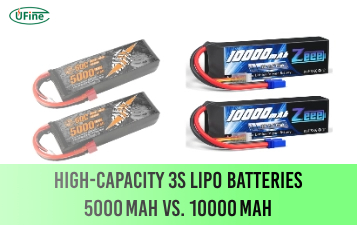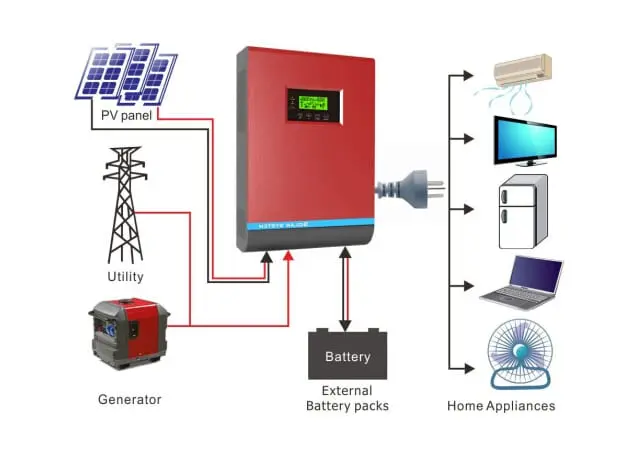In energy management, the battery inverter is crucial to modern power systems. Its importance lies in its role as a bridge between renewable energy sources and conventional grids, enabling efficient utilization and storage. Understanding its functionality, types, and applications is essential for navigating the evolving landscape of sustainable energy solutions.
Part 1. What is a battery inverter?
A battery inverter is a crucial component of a solar power system or any standalone energy storage system. It is responsible for converting the direct current (DC) electricity stored in batteries into alternating current (AC) electricity used to power household appliances, electronics, and other devices.
A battery inverter bridges the battery bank, electrical grid, or appliances you want to power. The efficient conversion and distribution of stored energy in batteries ensure its usability for various applications.
Part 2. Why is the battery inverter necessary?
a. Energy Independence and Backup Power
One of the primary reasons for using a battery inverter is to achieve energy independence and have a reliable backup power source. By integrating a battery inverter into a solar power system, users can store excess energy generated during the day in batteries and utilize it during periods of low or no sunlight, such as nighttime or during power outages. This ensures a continuous electricity supply, reducing reliance on the electrical grid and providing peace of mind.
b. Seamless Integration with the Grid
Battery inverters also facilitate seamless integration between renewable energy sources and the electrical grid. They enable the injection of surplus energy generated by solar panels or wind turbines back into the grid. This process, known as net metering or feed-in tariff, allows homeowners or businesses to earn credits or financial incentives for the excess electricity they contribute to the grid.
c. Load Shifting and Time-of-Use Optimization
Advanced battery inverters can optimize energy usage based on time-of-use electricity rates. Users can significantly reduce their electricity costs by storing electricity during off-peak hours when rates are lower and using it during peak-demand periods. This process, known as load shifting, helps achieve greater energy efficiency and financial savings.
Part 3. How does a battery inverter work?
DC to DC Conversion
The battery bank supplies direct current (DC) electricity, and the inverter converts it to a suitable voltage level. A DC-to-DC converter adjusts the voltage to match the requirements of the inverter.
DC to AC Conversion
The inverter converts the DC electricity from the battery bank into alternating (AC) electricity. Electronic components, such as power transistors and capacitors, mimic the waveforms and characteristics of utility-supplied AC power to achieve this.
Power Conditioning
The battery inverter also ensures the AC power generated is stable, clean, and meets the required voltage and frequency standards. It eliminates any voltage fluctuations or harmonic distortions that could damage connected devices.
Grid Connection
Suppose the battery system is connected to the electrical grid. In that case, the inverter synchronizes the generated AC power with the grid’s voltage and frequency. This process ensures a safe and seamless connection, allowing energy to flow bidirectionally between the battery system and the grid.
Part 4. Types of battery inverters
a. Standalone Inverters
Standalone inverters, also known as off-grid inverters, are designed for systems that operate independently of the electrical grid. These inverters typically work with batteries and other energy sources, such as solar panels or wind turbines, to provide a self-sufficient power supply in remote areas or during emergencies.
b. Grid-Tied Inverters
As the name suggests, grid-tied inverters cater to systems that connect to the electrical grid. These inverters enable surplus energy into the grid and allow users to draw power from the grid when needed. Users commonly employ them in residential and commercial settings to offset their energy consumption and potentially earn credits or financial incentives.
c. Hybrid Inverters
Hybrid inverters combine the functionalities of standalone and grid-tied inverters, offering greater flexibility and versatility. These inverters can operate in grid-connected and off-grid modes, making them suitable for systems requiring backup power capability and grid interaction. People widely use hybrid inverters in areas with unreliable grid supply or where achieving energy self-sufficiency is desired.
Part 5. Applications of battery inverters
a. Residential Energy Storage
In residential settings, battery inverters are commonly used with solar power systems to store excess energy generated during the day and provide power during nighttime or power outages. This allows homeowners to reduce their reliance on the grid, lower electricity bills, and have a reliable backup power source.
b. Commercial and Industrial Energy Management
Battery inverters play a crucial role in commercial and industrial sectors by enabling effective energy management strategies. They allow businesses to optimize energy usage, reduce peak demand charges, and participate in demand response programs. Additionally, battery inverters can provide backup power to critical systems in commercial establishments, ensuring uninterrupted operations during power outages.
c. Microgrids and Remote Areas
Battery inverters are instrumental in building microgrids in remote areas or regions with unreliable grid infrastructure. These self-contained energy systems can incorporate renewable energy sources and batteries, providing reliable power supply to communities, remote facilities, or off-grid installations.
d. Electric Vehicle Charging Infrastructure
Battery inverters are also utilized in electric vehicle (EV) charging infrastructure. They facilitate the integration of EV charging stations with the electrical grid, allowing efficient charging and grid management. Battery inverters can help balance the charging load, avoid grid congestion, and enable bidirectional energy flow between EVs and the grid for vehicle-to-grid (V2G) applications.
Part 6. FAQs
-
What is the benefit of a battery inverter?
A battery inverter provides energy independence, backup power, and cost savings through load shifting and time-of-use optimization. -
What are the disadvantages of an inverter?
Inverters have some energy loss, require maintenance, and can be sensitive to voltage fluctuations. They may also generate a small amount of noise. -
Are battery inverters safe?
Yes, battery inverters are generally safe when installed and used correctly. Still, it’s essential to follow safety guidelines to prevent accidents like electric shocks or fires. -
What is the lifespan of a battery inverter?
The lifespan of a battery inverter is typically around 10 to 15 years, with individual components potentially requiring replacement or repair during that time.
Related Tags:
More Articles

High‑Capacity 3S LiPo Batteries: 5000 mAh vs. 10000 mAh
Compare 3S LiPo 5000mAh vs 10000mAh batteries by weight, power, and use. Find the best fit for your drone, RC car, or boat setup.
Top 5 Applications for Small 3S LiPo Batteries
Small 3S LiPo batteries power drones, RC gear, wearables, and robotics with high energy and low weight. Making them ideal for compact electronics projects.
Building and Charging Your Own 3S LiPo Pack: A Step‑by‑Step Guide
Learn how to build, balance, and charge a 3S LiPo battery pack safely at home with this complete DIY guide for hobbyists and beginners.
How to Choose the Right LiPo Battery Plug Type?
Discover the best LiPo battery plug types, how to choose them, and expert tips for safe usage, soldering, and maintenance.
Choosing the Right Connector for Your 3S LiPo Battery
Choosing the right 3S LiPo connector depends on current, space, and use. Learn the pros and cons of XT60, JST, EC3, and more.




